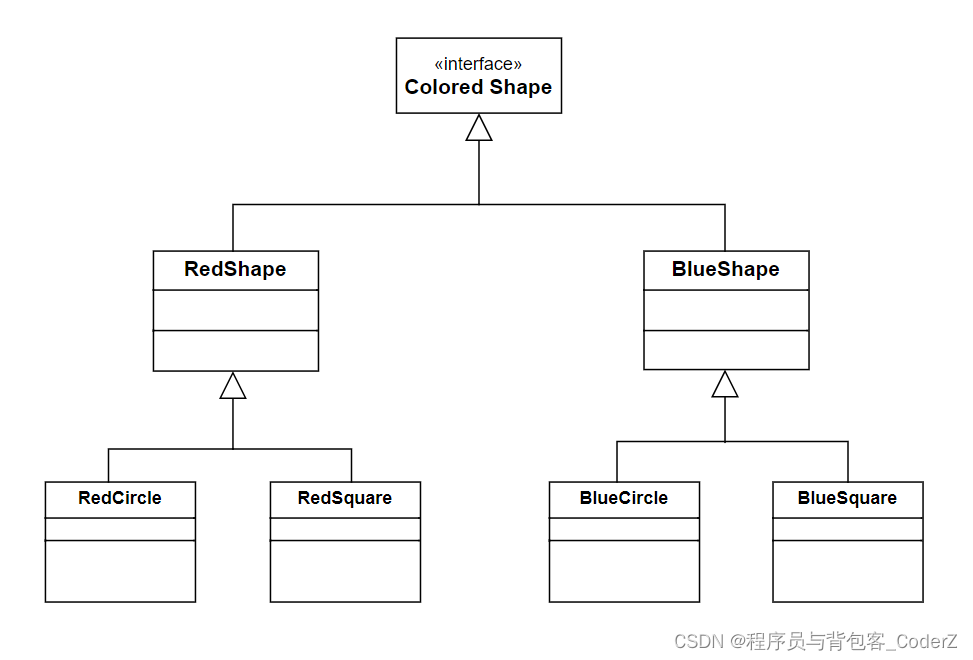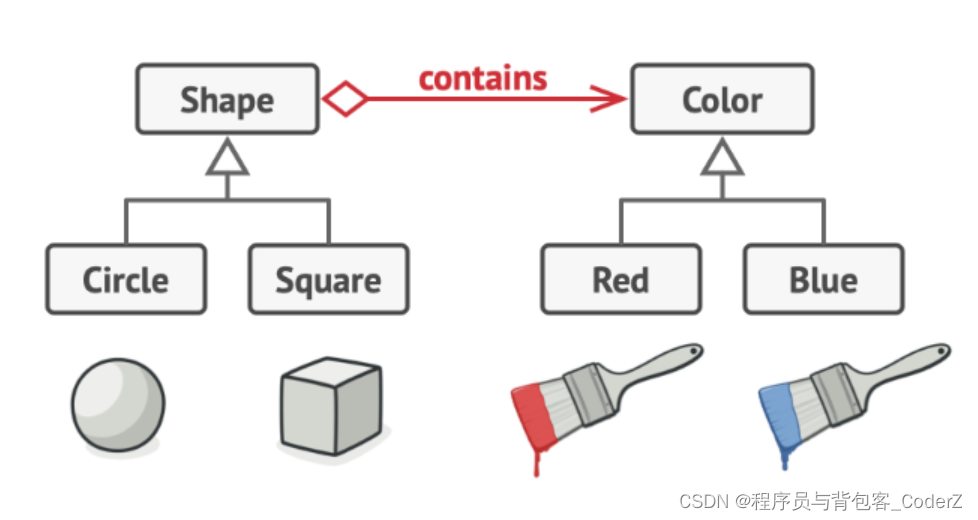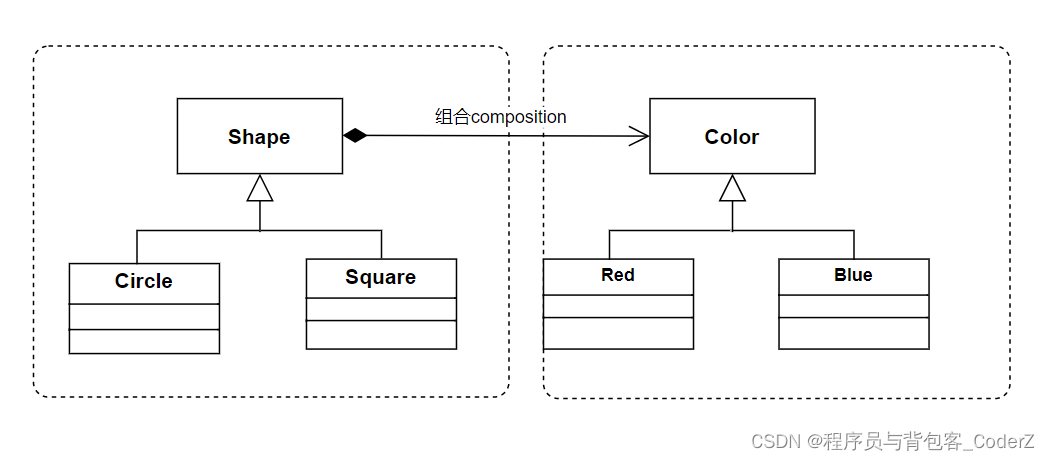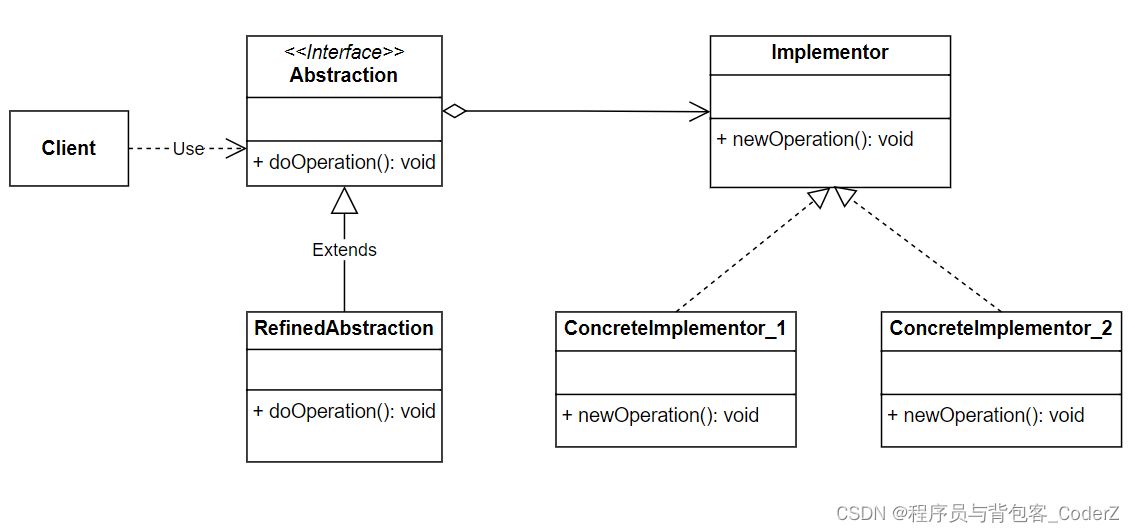一,桥接模式简介
桥接模式是一种结构型设计模式,用于将抽象与实现分离,这里的"抽象"和"实现"都有可能是接口函数或者类。
桥接模式让抽象与实现之间解耦合,使得开发者可以更关注于实现部分,调用者(Client)可以更关注于抽象部分。
桥接模式可以将一个复杂的类进行拆分为好几个类,开发者可以修改其中任意一个类的实现,而不影响其他类的正常运行,该模式可以降低代码的维护工作量,降低代码风险。
桥接模式的核心就是:抽象化(Abstraction)与实现化(Implementation)
抽象化:忽略一些细节,将具有共同特征的不同实体抽象为同一个对象。
实现化:为抽象化提供具体的逻辑和代码实现。
举个例子:
假设有一堆几何体,这些几何体有形状、颜色等特征,形状有:矩形、圆形,颜色有:红色、蓝色。
为了使用类来描述这些几何体,我们可以将他们抽象为四个子类:红色矩形,蓝色矩形,红色圆形,蓝色圆形。
按照以上方式,如果几何体还包含更多种类的形状和颜色,例如椭圆、绿色,那么这些特征通过排列组合产生的子类将会呈指数级增长。如果此时使用桥接模式,将会大大降低类与类之间的耦合,减少了开发期间的代码量。

对应UML类图:

桥接模式将继承关系改为组合关系,对于以上几何体的描述,我们使用一个类来描述几何体的矩形、圆形等形状,我们使用另一个类来描述几何体的红色、蓝色等颜色,最后将这两个类的实例进行组合。当需要改变类的颜色或形状的实现时,无需修改整个类的实现,只需要修改颜色或形状的实现即可。

对应UML类图:

二,桥接模式的结构
桥接模式主要涉及的类:
**1. 抽象角色类:**是一个类,定义了统一的对外接口,并定义了接口的组成结构,但是不包含接口对应的具体实现。
**2. 具体实现类:**是一个或多个类,该类包含了对抽象角色类的接口的具体代码实现。这些类可以根据需求变化而独立变化,且不会影响到其他类的功能。具体实现类与抽象角色类之间的关联方式采用的是组合而非继承。
**3. 桥接类:**充当了抽象角色类和具体实现类之间的桥梁,负责维护抽象角色类和具体实现类之间的关系,它允许客户端在运行时选择使用哪个具体实现类。
桥接模式的主要组件:
**1.Abstraction:**抽象类,提供统一的抽象接口。内部包含对Implementor类对象的引用。
**2.RefinedAbstraction:**扩充抽象类,有的教程里面称为"ExtendedAbstraction",Abstraction的子类,扩充Abstraction的抽象接口。
**3.Implementor:**实现类,提供了实现类的接口,这个接口的功能和以上的抽象接口不同。
**4.ConcreteImplementor:**提供了实现类的接口对应的代码逻辑。
桥接模式UML类图:

代码实现:
cpp
#include <iostream>
class Implementation {
public:
virtual ~Implementation() {}
virtual std::string newOperation() const = 0;
};
class ConcreteImplementationA : public Implementation {
public:
std::string newOperation() const override {
return "ConcreteImplementationA: Here's the result on the platform A.\n";
}
};
class ConcreteImplementationB : public Implementation {
public:
std::string newOperation() const override {
return "ConcreteImplementationB: Here's the result on the platform B.\n";
}
};
class Abstraction {
protected:
Implementation* implementation_;
public:
Abstraction(Implementation* implementation) : implementation_(implementation) {
}
virtual ~Abstraction() {
}
virtual std::string doOperation() const {
return "Abstraction: Base operation with:\n" +
this->implementation_->newOperation();
}
};
class RefinedAbstraction : public Abstraction {
public:
RefinedAbstraction(Implementation* implementation) : Abstraction(implementation) {
}
std::string doOperation() const override {
return "RefinedAbstraction: Extended operation with:\n" +
this->implementation_->newOperation();
}
};
void ClientCode(const Abstraction& abstraction) {
std::cout << abstraction.doOperation();
}
int main() {
Implementation* implementation_1 = new ConcreteImplementationA;
Abstraction* abstraction_1 = new Abstraction(implementation_1);
ClientCode(*abstraction_1);
std::cout << std::endl;
delete implementation_1;
delete abstraction_1;
Implementation* implementation_2 = new ConcreteImplementationB;
Abstraction* abstraction_2 = new RefinedAbstraction(implementation_2);
ClientCode(*abstraction_2);
delete implementation_2;
delete abstraction_2;
return 0;
}运行结果:
cpp
Abstraction: Base operation with:
ConcreteImplementationA: Here's the result on the platform A.
RefinedAbstraction: Extended operation with:
ConcreteImplementationB: Here's the result on the platform B.三,桥接模式的应用场景
**系统组件升级:**当需要为现有系统增加新功能或替换已有功能,但又不希望改变原有接口时。
**跨平台应用开发:**使用桥接模式来处理不同操作系统或硬件平台的差异,例如在移动端APP应用中,UI组件同时兼容ios和Android平台。
**第三方插件开发:**使用桥接模式开发出可支持多种第三方服务的组件,例如移动支付api。
**API扩展:**当API的功能需要被扩展,又希望保持原有API的稳定时,使用桥接模式可以隐藏实现细节。
四,桥接模式的优缺点
桥接模式的优点:
分离接口的抽象与实现部分。
替代了继承的实现方式,代码的可复用性更强。
桥接模式可以修改任意一个模块的功能实现而不影响整个系统。
可以向用户隐藏实现细节。
降低了类之间的依赖性。
代码的可维护性很强,可以根据需求灵活地更换实现模块。
桥接模式的缺点:
引入了额外的抽象层,使系统变得更复杂。
会额外增加系统的理解与设计难度。
接口调用增多,带来额外的性能开销。
五,代码实战
代码实战:
生产不同颜色和不同车型的汽车
cpp
#include<iostream>
#include<string>
using namespace std;
class IColor
{
public:
virtual string Color() = 0;
};
class RedColor : public IColor
{
public:
string Color()
{
return "of Red Color";
}
};
class BlueColor : public IColor
{
public:
string Color()
{
return "of Blue Color";
}
};
class ICarModel
{
public:
virtual string WhatIsMyType() = 0;
};
class Model_A : public ICarModel
{
IColor* _myColor;
public:
Model_A(IColor *obj) :_myColor(obj){}
string WhatIsMyType()
{
return "I am a Model_A " + _myColor->Color();
}
};
class Model_B : public ICarModel
{
IColor* _myColor;
public:
Model_B(IColor *obj) :_myColor(obj){}
string WhatIsMyType()
{
return "I am a Model_B " + _myColor->Color();;
}
};
int main()
{
IColor* red = new RedColor();
IColor* blue = new BlueColor();
ICarModel* modelA = new Model_B(red);
ICarModel* modelB = new Model_A(blue);
cout << "\n" << modelA->WhatIsMyType();
cout << "\n" << modelB->WhatIsMyType() << "\n\n";
delete red;
delete blue;
return 0;
}运行结果:
cpp
I am a Model_B of Red Color
I am a Model_A of Blue Color六,参考阅读
https://refactoring.guru/design-patterns/bridge
https://design-patterns.readthedocs.io/zh-cn/latest/structural_patterns/bridge.html